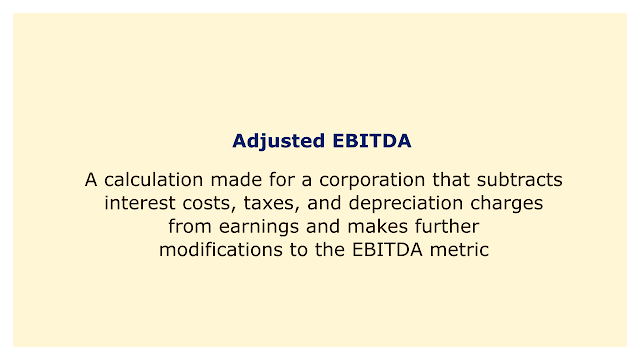 |
| Image: Moneybestpal.com |
EBITDA, or earnings before interest, taxes, depreciation, and amortization, is one of the financial measurements that analysts and investors use the most frequently. EBITDA is a gauge of an organization's operating profitability since it reveals how much revenue is generated by its core operations, without taking into account the impact of financing, accounting, and tax considerations.
EBITDA can be affected by a number of non-cash and non-recurring things that can not accurately reflect the true operating effectiveness or cash flow production of the company, hence it is not a perfect measure of a company's performance. For instance, a business may have one-time costs or benefits as a result of restructuring, legal action, asset sales, or impairments that have an impact on EBITDA but are unrelated to ongoing operations. Alternately, a business may employ various depreciation or amortization techniques that have an impact on EBITDA but have no impact on cash flow.
Some businesses utilize an adjusted EBITDA figure, which is derived by making certain modifications to the conventional EBITDA formula, to solve these constraints. The purpose of adjusted EBITDA is to portray a company's underlying operating performance and potential for cash flow production in a more precise and consistent manner. Moreover, organizations in other markets or industries that can have various capital structures, tax regimes, or accounting standards can be contrasted using adjusted EBITDA.
The adjustments made to EBITDA vary depending on the company and the industry, but they typically include adding back or subtracting certain items that are considered non-cash, non-recurring, or non-operating in nature. Some of the most common adjustments are:
- Stock-based compensation: The value of equity awards given to employees or executives as part of their remuneration package is reflected in this non-cash charge. Cash flow is unaffected by stock-based compensation, while EBITDA is decreased.
- Restructuring costs: Severance payments, lease terminations, asset write-downs, or integration charges are examples of one-time expenditures or income connected to restructuring or simplifying a business' activities. EBITDA is impacted by restructuring expenditures, which are not a reliable indicator of a company's ongoing operations.
- Impairment charges: These expenses are non-cash and represent the decline in an asset's carrying value as a result of degradation, obsolescence, or changes in market conditions. EBITDA is decreased by impairment costs, but cash flow is unaffected.
- Gain or loss on asset sales: These one-time gains or losses originate from the sale or disposal of an asset that is not essential to a company's fundamental operations. Gains or losses on asset sales have an impact on EBITDA but may not necessarily reflect how a business is actually doing.
- Other income or expenses: Any additional costs or revenues, such as interest income or expense, foreign exchange gains or losses, settlements from legal actions, charitable contributions, or fines, that are not directly tied to a company's main business operations fall under this category. EBITDA is impacted by other earnings or costs, however, these items may not necessarily reflect how well a business is functioning.
The formula for adjusted EBITDA can be expressed as:
Adjusted EBITDA = EBITDA + Stock-based compensation + Restructuring costs + Impairment charges - Gain or loss on asset sales - Other income or expenses
Certain businesses, however, may employ a different method that begins with net income and then adds back interest, taxes, depreciation, amortization, and other adjustments. Whatever the starting position, the outcome ought to be the same.
Adjusted EBITDA is widely used by investors and analysts as a proxy for a company's cash flow generation potential and operating efficiency. Adjusted EBITDA can also be used to calculate various financial ratios, such as:
- Adjusted EBITDA margin: This is derived by dividing revenue by adjusted EBITDA. It quantifies the amount of revenue that is transformed into adjusted EBITDA. A business that has a higher adjusted EBITDA margin is more successful and effective.
- Adjusted EBITDA multiple: This is determined by dividing enterprise value (EV) by adjusted EBITDA. It gauges the price an investor is prepared to pay for every dollar of adjusted EBITDA. A lower adjusted EBITDA multiple denotes a lower valuation.
- Debt/Adjusted EBITDA: This is determined by subtracting total debt from adjusted EBITDA. Using adjusted EBITDA, it calculates how long it would take a corporation to pay off its debt. Lower debt-to-adjusted EBITDA ratios suggest lesser leverage and a better credit profile.
However, adjusted EBITDA also has some drawbacks and limitations that should be considered when using it as a financial metric. Some of the main drawbacks are:
- Lack of standardization: Adjusted EBITDA does not have a standard definition or formula. It might be challenging to compare adjusted EBITDA among companies since they may employ different adjustments or procedures to determine their adjusted EBITDA. The adjusted EBITDA calculation used by each firm should constantly be verified by investors and analysts, who should also make any necessary revisions.
- Potential for manipulation: Adjusted EBITDA is not subject to the same accounting rules and regulations as other financial measures because it is not a GAAP or IFRS measure. This allows businesses more freedom and discretion in deciding which factors to include or leave out of their adjusted EBITDA calculation, which could lead to results that are inflated or skewed and do not accurately reflect the business's actual economic situation. By removing unfavorable factors or inserting advantageous ones, companies might utilize adjusted EBITDA to hide their subpar financial performance or condition.
- Not a cash flow measure: Although adjusted EBITDA is frequently used as a stand-in for cash flow, it does not provide a precise indication of a company's ability to generate cash flow. The changes in working capital, capital expenditures, interest payments, taxes, dividends, and other cash inflows or outflows that have an impact on a company's cash flow are not taken into account by adjusted EBITDA. A company's actual cash flow may therefore be overstated or understated by adjusted EBITDA.
